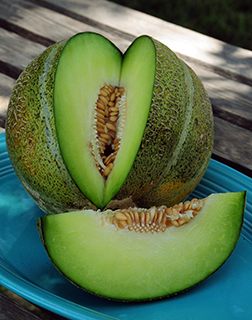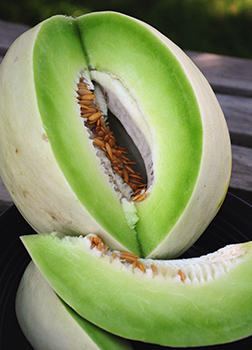Your cart is currently empty!
Honeydew and Mixed Melons
Growing Melons.
Melons are the perfect, portable, party food. Tuck it under your arm and go. You will be the hit of the barbecue with our specialty melons. Each variety has unique flavor and testing melons in our seed fields is a real hardship, but someone has to do it! Grow several kinds; early, midseason and late maturing melons. There may be more than one picnic to attend.
Honeydew, Casaba, Crenshaw, Canary, Ogen and Persian melon seeds may be planted directly in the ground when soil temperature reaches 65º and all danger of frost is past. Heavy feeders, they prefer a sandy loam amended with composted manure. In cooler climates, start seedlings inside, transplanting when putting out the rest of your warm weather crops. Planting in hills, 3′ apart in rows 5′ or 6′ apart is recommended. Seed should be planted at a 1″ depth. water at the base of the plant or with irrigation every two weeks until melons reach softball size. Drier soil at this stage improves sugar content. Unlike cantaloupes, honeydews do not slip of the vine. They need to be cut with a sharp knife. They are ripe when the skin is creamy white and waxy. You can actually see microscopic hairs on a ripe honeydew.
Honeydews are vulnerable to cucumber beetles. We sparingly spray with pyrethrum in our fields, as our bees are vital to our operation. At home, you can vacuum the striped cucumber beetles off the vines. Empty the vacuum into soapy water to kill them.
Good companion crops are nasturtium, catnip, radish, marigolds and mints. A bad companion crop is potatoes.
-
 Melon – Ogen (Ha’Ogen)$2.60 – $47.30
Melon – Ogen (Ha’Ogen)$2.60 – $47.30 -
 Melon – Yellow Canary$2.60 – $33.20
Melon – Yellow Canary$2.60 – $33.20 -
 Honeydew – Sweet Delight$2.60 – $36.00
Honeydew – Sweet Delight$2.60 – $36.00 -
 Honeydew – Orange Flesh$2.60 – $63.40
Honeydew – Orange Flesh$2.60 – $63.40 -
 Melon – Crenshaw$2.60 – $61.30
Melon – Crenshaw$2.60 – $61.30 -
 Honeydew – Green Meated$2.60 – $40.30
Honeydew – Green Meated$2.60 – $40.30 -
 Honeydew – Golden Honeymoon (Gold Rind Honeymoon)$2.60 – $29.70
Honeydew – Golden Honeymoon (Gold Rind Honeymoon)$2.60 – $29.70 -
 Melon – Casaba Golden Beauty$2.60 – $61.30
Melon – Casaba Golden Beauty$2.60 – $61.30 -
 Cantaloupe – Visa F1 Hybrid$4.30 – $215.30
Cantaloupe – Visa F1 Hybrid$4.30 – $215.30 -
 Melon – Sapomiel F1$5.40 – $324.70
Melon – Sapomiel F1$5.40 – $324.70 -
 Melon – Dove F1$5.60 – $354.30
Melon – Dove F1$5.60 – $354.30